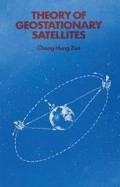Abstract
Telecommunication by means of satellites is by now a well-known application of space technology. Of the many orbits available for communication satellites, the 24-hr geostationary (equatorial, circular-synchronous) satellite offers a unique Earth-relative geometry and kinematics, thereby providing both economic and operational advantages for global communications. As shown in Figure 1.1, three geostationary satellites can give almost complete Earth coverage and hence, continuous world wide communication service. Of course, redundant units would be needed for a complete system in order to allow for communication outages.
Access this chapter
Tax calculation will be finalised at checkout
Purchases are for personal use only
Preview
Unable to display preview. Download preview PDF.
References
Bargellini, P.L.; Communications Satellite Technology, AIAA Progress in Astronautics & Aeronautics 33 (1974).
Bargellini, P.L.; Communications Satellite System, AIAA Progress in Astronautics & Aeronautics 32 (1974).
deMendona, F.; ‘Education through Satellite in Brazil’, 27th International Astronautical Congress, IAF-76-l37, Anaheim, California (1976).
Feldman, N.E. and Kelly, C.M.; Communications Satellite for the 70’s: System, AIAA Progress in Astronautics & Aeronautics 26 (1971).
Feldman, N.E. and Kelly, C.M.; Communications Satellite for the 70’s: Technology, AIAA Progress in Astronautics & Aeronautics 25 (1971).
Glaser, P.E.; ‘Evolution of the Satellite Solar Power Station (SSPS) Concept’, J. of Spacecraft and Rockets 13, 573 (1976).
Hawkridge, D.G.; ‘Satellites and Education: Prospects and Problem’, J. of the British Interplanetary Society 30, 147–154 (1977).
Hogwood, P.; ‘Palapa — Indonesia to the Fore’, J. of the British Interplanetary Society 30, 127–130 (1977).
Jarett, D.; Satellite Communications: Future Systems, AIAA Progress in Astronautics & Aeronautics 54 (1977).
Jones, W.S. and Hunter, M.W.; ‘Solar Power Satellite: The Laser Option’, Astronautics & Aeronautics 17, 59, and 67 (1979).
La Vean, G.E. and Martin, E.J.; ‘Communications Satellites: The Second Decade’, Astronautics & Aeronautics 12, 54–61 (1974).
La Vean, G.E. and Schmidt, W.G.; Communications Satellite Developments: System, AIAA Progress in Astronautics & Aeronautics 41 (1976).
La Vean, G.E. and Schmidt, W.G.; Communications Satellite Developments: Technology, AIAA Progress in Astronautics & Aeronautics 42 (1976).
Lagrade, J.B.; ‘Setting Up of a Worldwide Maritime Satellite System’, J. of the British Interplanetary Society 30, 123–126 (1977).
Marsten, R.B.; Communications Satellite System Technology, AIAA Progress in Astronautics & Aeronautics 19 (1966).
Roa, B.S., Karnik, K.S., and Gupta, V.D.; ‘A Study of Satellite Television Broadcasting System in India’, J. of Spacecraft and Rockets 10, 537–540 (1973).
Rosen, H.A. and Jones, C.R.; ‘CTS (Space Transportation System) — Optimized Satellite Concept’, Astronautics & Aerongutics 15 48–53 (1977).
Ruppe, H.O.; ‘A History of the Communications Satellite’, J. of the British Interplanetary Society 30, 131–134 (1977).
Shrivastava, S.K.; ‘Orbital Perturbations and Stationkeeping of Communication Satellites’, J. of Spacecraft and Rockets 15, 67–78 (1978).
Williams, J.R.; ‘Geosynchronous Satellite Solar Power’, Astronautics & Aeronautics 13, 46–52 (1975).
Report to the President and the Congress, Communications Satellite Corporation, Washington D.C., Nov. 30, 1978.
Astronautics & Aeronautics, monthly issues (1974–1983).
Spaceflight, monthly issues (1974–1986).
Aerospace America, monthly issues (1984–1986).
Author information
Authors and Affiliations
Rights and permissions
Copyright information
© 1989 Springer Science+Business Media Dordrecht
About this chapter
Cite this chapter
Zee, CH. (1989). Introduction. In: Theory of Geostationary Satellites. Springer, Dordrecht. https://doi.org/10.1007/978-94-009-2573-1_1
Download citation
DOI: https://doi.org/10.1007/978-94-009-2573-1_1
Publisher Name: Springer, Dordrecht
Print ISBN: 978-94-010-7662-3
Online ISBN: 978-94-009-2573-1
eBook Packages: Springer Book Archive

